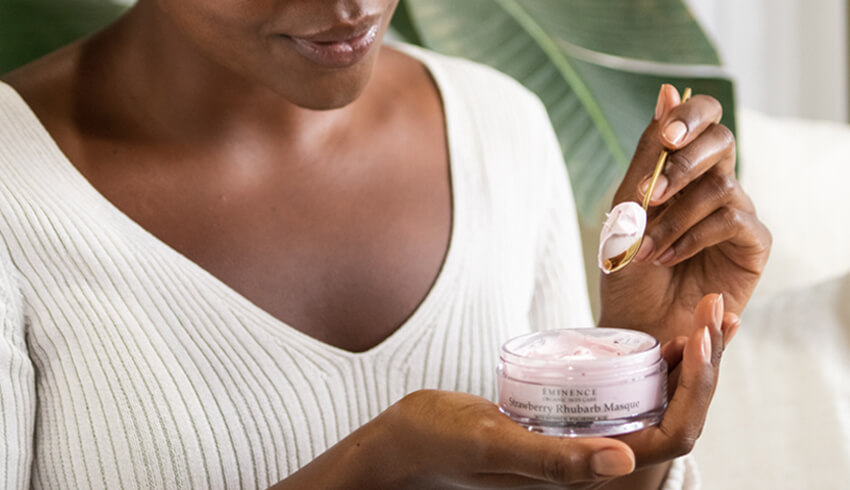
Face Masks 101: Benefits, Types & How Often You Should Use One
Table of Contents
There’s nothing quite like a face mask to step up your skin care routine. The right mask is not just an indulgent treat — it can also tackle key skin concerns and conditions, from dryness and dehydration to large pores and acne. Depending on your age, some masks will be more beneficial than others. Read on to learn about the types of face masks, how to apply it and how to choose the right one for your age range and unique complexion.
Benefits Of Masking | Types Of Face Masks | Face Mask For Your Skin Type | Face Mask For Your Age | How Often Should You Use A Face Mask?
Benefits Of Masking: What You Didn’t Know About Masks
Just like a serum or moisturizer, a face mask is a skin care vehicle. It delivers highly concentrated actives, vitamins and nutrients to the skin to improve its overall health. The difference? Face masks are occlusive — they create a physical barrier that locks in beneficial ingredients, allowing the skin to absorb more efficiently.
Face masks are designed to be used intermittently to give your skin an instant boost. Depending on what your skin needs, there is a mask that can do one (or a combination) of the following:
- Hydrates and moisturizes dry skin
- Refines large pores
- Improves skin texture
- Absorbs excess oil and dirt
- Decongests clogged pores
- Minimizes the appearance of fine lines and wrinkles
- Enhances elasticity
- Improves the look of breakouts
- Brightens dark spots
To help you find your “mask match,” here’s a quick cheat sheet about the different types of face masks on the market.
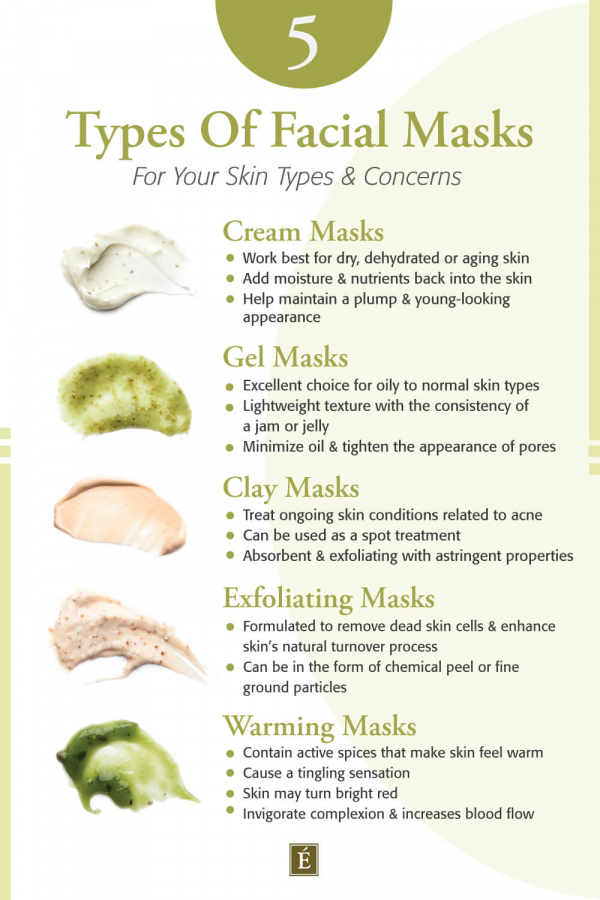
Types Of Face Masks Available
With so many options out there, how do you choose the right face mask for you? Here’s what you need to know about each type of mask texture.
Cream
Think of the texture of a rich moisturizer — that’s the best way to describe the feel of a cream-based mask. These face masks do wonders for adding moisture and nutrients back into the skin, helping maintain a plump and young-looking appearance. Eminence Organics International Educator Brian Goodwin lets us in on a skin care secret: “An insider tip is that most of our cream-based masks can be used as a leave-on treatment.”
One option is our cream-based Bamboo Age Corrective Masque that smooths the appearance of dry, dehydrated or aging skin overnight. Our Coconut Cream Masque works best with dry, dehydrated or aging skin while our Clear Skin Probiotic Masque suits acne-prone and oily skin types. Our Kombucha Microbiome Leave-On Masque is a no-rinse probiotic skin care formula that suits all skin types. It is designed to support the skin’s natural recovery process and maintain the a healthy skin moisture barrier. This rich, slow-absorbing mask provides soothing hydration and comfort to dry, dull skin.

Gel
Gel masks, on the other hand, have the consistency of a jam or jelly. With their lightweight texture, they are an excellent choice for oily to normal skin types. Many gel masks include astringent ingredients like raspberries and blackberries which minimize oil and tighten the appearance of pores. Others are formulated with hydrating ingredients like stone crop and honey which replenish the look of dry and dehydrated skin.
Our Citrus & Kale Potent C+E Masque is suited for those looking for a firmer-looking complexion. It contains a cocktail of rhubarb extract, avocado oil, leafy greens and citrus. Whichever mask you choose, you can amplify your results with this skin care tip from Brian: Apply your favorite gel-based mask before hopping in the shower to make it an active in-shower treatment.
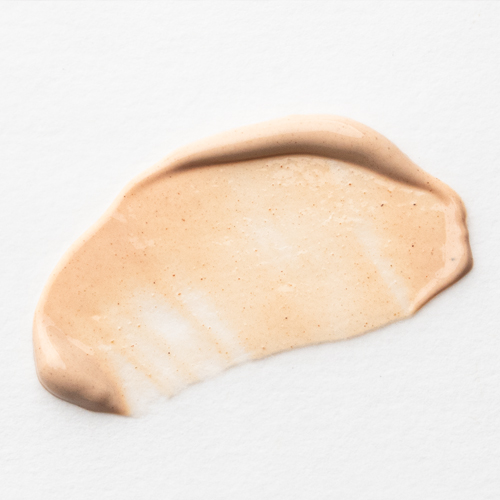
Clay
With its absorbent, exfoliating and astringent properties, clay treats ongoing skin conditions related to acne such as excess oil and inflammation. Pro skin care tip: Did you know a clay mask can double as a spot treatment? Lead Skin Care Trainer Natalie Pergar recommends using the Acne Advanced Clarifying Masque to treat bumpy and congested skin: “It’s nice and creamy in texture, and you literally need a little bit … Just hit those little areas and let it dry.”
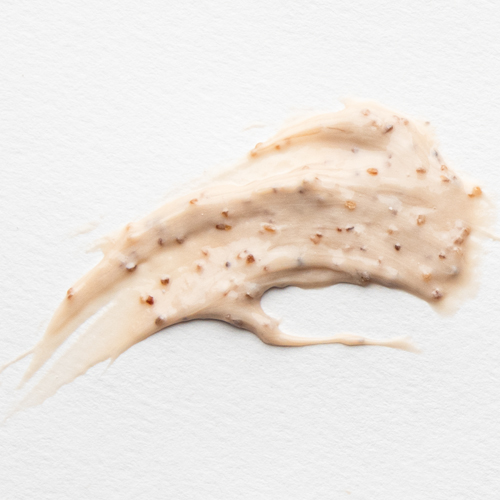
Exfoliating
Exfoliating masks are formulated to remove dead skin cells and enhance your skin’s natural turnover process. This type of face mask may take the form of a chemical peel which employs alpha or beta hydroxy acids to dissolve dead skin cells and clear them from the skin’s surface. The hypoallergenic Radish Seed Refining Peel reduces the appearance of problem skin and the look of fine lines and wrinkles. For pore-clearing exfoliating benefits, our Product Support Representatives recommend pairing it with either the Yellow Sweet Clover Anti-Redness Masque or the Seabuckthorn Balancing Masque. Use the Seabuckthorn Balancing Masque if you have combination skin. For drier skin types, we recommend the Yellow Sweet Clover Anti-Redness Masque.

Warming
Warming masks contain active spices like paprika and cinnamon that make the skin feel warm. They intentionally cause a tingling sensation, and in some cases, the skin may turn bright red. The immediate effects last from 20 – 60 minutes before revealing a healthy, glowy complexion. In the same way that increased energy is a benefit of exercise, invigorating your complexion and increasing your blood flow provides a great workout for your skin.
However, these masks aren’t for everyone: If you have sensitive skin, you’re better off choosing a cream or gel-based mask that won’t exacerbate your symptoms.
Notably, our Eight Greens Phyto Masque — Hot has been recognized as a 2020 Allure Best Of Beauty Award winner within the “Clean Beauty” category. Blended from whole plants, seeds and spices, this formula invigorates and rejuvenates the appearance of the skin.
Watch our In The Mix video below to find out more about our warming face masks: :
Our Turmeric Energizing Treatment is also designed to awaken dull, tired skin. Formulated with turmeric as well as citrine gemstones and zeolite, this mask only needs water to activate a fluffy mousse bursting with energy.
The Best Face Mask For Your Skin Type
If you prefer to use one mask at a time, it’s important to choose the right face mask for your skin type and skin concerns. To get your wheels turning, here are our suggestions for each skin type:
Dry Skin
Dry skin often means dealing with flaky patches, a scaly skin texture or cracked, itchy skin. Boasting shea butter and grape seed oil, the Strawberry Rhubarb Masque provides important fatty acids to help with the appearance of skin softness and dryness.
Oily Skin
Oily skin is characterized by an overproduction of sebum in the skin. Often this excess oil may interact with bacteria and dead skin cells resulting in breakouts. Try the Citrus & Kale Potent C+E Masque for this skin type as it contains the Vitamins C+E to improve the appearance of skin health.
Combination Skin
It can be frustrating to develop oily patches on your chin and forehead but dryness elsewhere such as on your cheeks. The Snow Mushroom & Reishi Masque helps to balance the look of the skin by firming its appearance and revealing a smooth radiance.
Sensitive Skin
Those with sensitive skin should carefully read labels and conduct patch tests for any new product before applying it all over the face. If you do have a reaction, you can apply the Calm Skin Arnica Masque to improve the look of redness and irritation.
Normal Skin
If you have normal skin, then your goal is to maintain your skin’s health. The Stone Crop Masque contains stone crop, lemon and other ingredients that reduce the appearance of wrinkles and improve the appearance of the skin.
And, for particular skin concerns and conditions:
The Best Type Of Face Mask For Your Age
Now that you know what product suits you by skin type, you can also filter based on ingredients suited to your age bracket. According to our Product Support Team, here are their suggestions based on different age ranges:
How Often Should You Use A Face Mask?
Now that you’ve learned the basics, how often should you use a face mask? We recommend adding a face mask to your skin care routine once or twice a week. Masking should follow cleansing, toning and applying a facial essence. These steps clear impurities and excess oil, provide a base layer of hydration and prep your skin to better absorb the benefits of your face mask.
Once you’re ready, follow these skin care tips to apply a face mask properly:
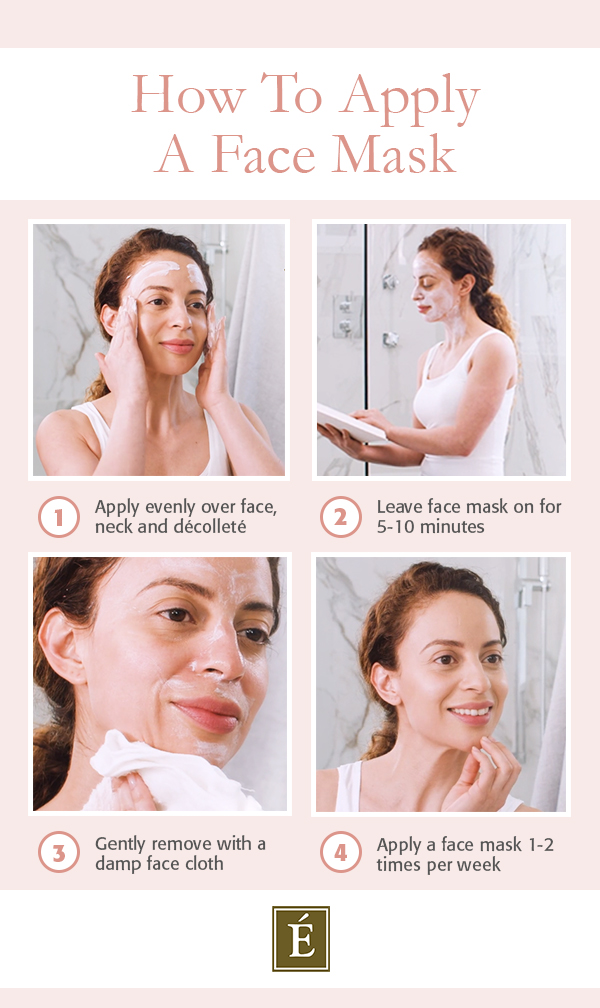
1. Apply Mask Evenly
It may be tempting to slather on an inch-thick layer of product, but more isn’t necessarily better. A cherry-sized amount is plenty to achieve the right results. Natalie advises evenly applying this amount in a “pantyhose-thin” layer over the entire face. Pro tip: Use facial massage techniques to amp up the benefits of this part of your routine!
Remember, Eminence Organics face masks contain concentrated amounts of beneficial vitamins and nutrients. We recommend adding two to three drops of water to your product and warming it between your hands before massaging it into your face –— especially if the product is gel-based. This will allow for more slip, easier application and (bonus!) less product waste.
2. Remember To Include Your Neck & Décolleté
That cherry-sized amount is just enough to also include your neck and décolletage. These areas take on the visible signs of age much earlier than the face due to their exposure to environmental stress — and they’re easily forgotten in a skin care routine. Pay these areas a bit of extra attention by including them in your face mask application.
3. Leave On For 5 – 10 Minutes
Most masks can be kept on for five to 15 minutes, but the duration can vary from mask to mask. Some face masks act quickly and can be removed after a short period of time; others can be left on as an overnight treatment to deeply hydrate your skin while you sleep. We always advise reviewing the label directions to apply your particular product so you know just the right time to remove it.
4. Remove Gently With A Damp Cloth
Don’t undo the benefits of your face mask by aggressively scrubbing it off. Instead, be delicate with your complexion. Use lukewarm water to gently remove the mask from your face. If you choose to use a washcloth, ensure it’s clean and has soft fibers that won’t irritate your skin.
Watch this video for a step-by-step guide on how to apply a face mask:
Do you have any favorite masks? We’d love to hear about them! Share them with us in the comments below and join the conversation on social media.
This article was originally written in September 2019.

